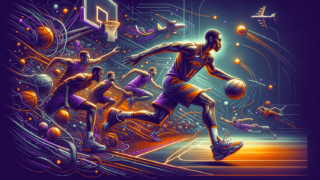
Ball screens have become one of the most frequented offensive strategies in today’s fast-paced and dynamic game of basketball. Mastering the art of defending against ball screens will not only make you a formidable force on the court but also elevate your team’s defensive capabilities. Get ready to dive into the ins and outs of effectively defending against ball screens, as we explore various techniques and tactics in our fun and professional guide, titled ‘How to Defend a Ball Screen in Basketball’. Sharpen your skills and become the defensive ace you always knew you could be!
How to Defend a Ball Screen in Basketball
To defend a ball screen in basketball, employ a defensive strategy that accounts for your team’s strengths and your opponents’ tendencies. Common techniques include hedging, switching, going over or under the screen, and trapping the ball handler. Communicate with your teammates, anticipate the screen, and maintain an athletic stance to position yourself effectively and disrupt the offense’s rhythm.
Understanding the Basics of Ball Screen Defense
Before diving into the techniques of defending against ball screens, it’s essential to understand their importance in basketball. Ball screens create various offensive opportunities, including driving lanes, open shots, and potentially forcing mismatches. To effectively disrupt these opportunities, you’ll need to adapt your defensive approach depending on the basketball situation and your team’s coordination. Let’s explore the core concepts of ball screen defense to provide a solid foundation for your improved defensive abilities.
Communication is Key
Defending against ball screens begins with excellent communication among teammates. A well-timed and clear call lets the defender know that a screen is coming, enabling them to be prepared and position themselves accordingly. Ensure that players voice their intentions and adjustments so that everyone on the court knows precisely what’s happening, eliminating any confusion that might lead to a defensive breakdown.
Mastering Defensive Stance and Footwork
Good stance and footwork are crucial for ball screen defenders. Maintain an athletic stance with knees bent and weight on the balls of your feet, ready to react quickly and efficiently. Keep your center of gravity low and stay agile, moving laterally as needed. When navigating around screens, use quick, precise footwork to avoid getting stuck behind the screen or committing unnecessary fouls.
Breaking Down Ball Screen Defense Techniques
Now that you have a solid grasp of the fundamentals, let’s delve into various ways to defend against ball screens in basketball. By understanding each technique’s nuances, you’ll be ready to implement the most effective approach for any given situation.
Hedging
Hedging involves the screener’s defender stepping out momentarily to impede the ball handler’s progress while the on-ball defender works to recover their position. This technique aims to disrupt the ball handler’s rhythm, force them away from the basket, and stall the offensive attack. There are primarily two types of hedging:
- Soft hedge: The defender stays relatively close to the screener, providing just enough resistance to slow down the ball handler without committing fully.
- Hard hedge: The defender aggressively steps out to force the ball handler to move further from the basket, creating more time for the on-ball defender to recover their position.
When implementing a hedge, defenders need to watch their distance and avoid creating unnecessary contact or getting beaten off the dribble.
Switching
Switching is a popular ball screen defense technique that requires excellent communication and quick decision-making from both defenders involved. When the screen is set, and the ball handler starts to move, the on-ball defender quickly switches onto the screener’s defender, while the screener’s defender takes over guarding the ball handler. This approach can effectively eliminate open shooting opportunities and penetration, but it may also result in mismatches if executed poorly.
Fighting Over or Under the Screen
Opting to fight over or under the screen is a more traditional approach and depends on the ball handler’s abilities and the screener’s position. Each method offers unique advantages and challenges:
- Over the screen: The on-ball defender moves around the screen, staying between the ball handler and the basket. This technique is useful against strong shooters who might exploit the space created by going under the screen.
- Under the screen: The on-ball defender goes below the screen, taking a more direct path to recovering their defensive position. This strategy is effective against slower or weaker shooters, as it encourages them to take longer, contested shots instead of penetrating the lane.
In most cases, fighting over the screen is prioritized unless scouting reports dictate otherwise.
Trapping the Ball Handler
Trapping requires coordinated teamwork and high defensive intensity. Both defenders converge on the ball handler, aiming to force a turnover, bad pass, or poor shot. Although this strategy can generate disruptive pressure, it also leaves the screener open momentarily, potentially creating an offensive advantage if the ball handler escapes the trap successfully. Trapping should be employed strategically and with proper support from weak-side defenders to minimize risk.
Adjustments and Counters for Elite Basketball Competition
As you progress in your basketball journey, you might encounter more challenging situations or elite-level competition. Being able to adapt and counter the offense’s moves is essential when defending against ball screens at the highest levels of the game.
Identifying Mismatches
As you analyze your opponents’ tendencies, pay close attention to potential mismatches created by screens or other offensive actions. If a defender switches, ensure they can handle guarding a player with a different position, height, or skill set. Consider adjusting personnel, positioning, or strategy to avoid being exploited through mismatches.
Adapting to Versatile or Stretch Bigs
The rise of versatile or stretch bigs in basketball presents new challenges for ball screen defense. These players can set screens and then quickly pop out to the perimeter, making it more difficult for traditional post defenders to guard them effectively. In these situations, consider switching the defending big onto a perimeter player or adjusting your overall defensive scheme to neutralize their impact.
Putting It All Together: Practicing Ball Screen Defense
With the knowledge of various ball screen defense techniques at your disposal, it’s essential to put them into practice. Incorporate these tactics into your basketball workouts, team practices, and live game situations. The more familiar you become with each method and the better you can read the offense, the more effective you’ll become at defending ball screens in basketball.
Drills for Ball Screen Defense
There are plenty of drills that can help you develop your ball screen defense skills, from individual footwork exercises to team-based scenarios. Some examples include:
- 2-on-2 Ball Screen Drills: These drills involve one screener and one ball handler against two defenders, simulating real game scenarios with limited space and forcing players to communicate and make quick decisions.
- Shell Drill Variations: The classic Shell Drill can be modified to include ball screen actions, requiring the entire defense to respond and adjust accordingly in a 4-on-4 or 5-on-5 setting.
- Defensive Slide Drills: Although not specific to ball screen defense, improving your defensive slide and overall lateral quickness will prove invaluable when navigating screens and recovering your position on the court.
By incorporating these drills and strategies into your practice routine, you’ll undoubtedly become a more versatile and impactful defender when facing ball screens in basketball. Remember always to communicate, adjust, and trust your training when stepping onto the court. And most importantly, have fun!
Developing a Personal Defensive Philosophy
In addition to learning and practicing various ball screen defense techniques, it’s essential to develop your personal defensive philosophy. Every player has unique strengths, weaknesses, and styles that they bring to the court; thus, understanding which techniques best suit your individual ability is critical. In this section, let’s explore some factors to consider while developing your personal defense against ball screens.
Analyzing Your Strengths and Weaknesses
Start by assessing your defensive skills by identifying your strengths and areas in need of improvement. Are you quick on your feet, making it easy to slide around screens? Or are you physically strong, capable of holding your ground against bigger opponents? Consider these factors when making defensive decisions:
- Speed: Quick, agile players often excel at fighting over screens and keeping up with faster ball handlers.
- Strength: Physically imposing defenders can effectively hedge or trap, using their size to disrupt the offense.
- Anticipation: Players with a keen sense for predicting and reading opponents’ actions may excel at switching or trapping at opportune moments.
Understanding Opponents’ Tendencies
In every game, it’s crucial to study your opponents and recognize their tendencies involving ball screens. Learning their preferred routes, handoffs, and attacks will allow you to employ the most appropriate defensive technique at any given moment. Understanding opponents’ habits such as:
- Main ball handler: Is the player a pass-first point guard or a shoot-first wing player?
- Screener preferences: Does the screener prefer to roll, slip, or pop after setting the screen?
- Play-calling: Can you identify offensive sets or actions that typically involve screens?
Armed with this knowledge, you’ll be better equipped to make impactful decisions regarding ball screen defense.
Learning from Expert Defenders and Coaches
To take your ball screen defense to the next level, study the techniques employed by top players and coaches in the game. By observing and emulating their methods, you’ll gather valuable insights that can be incorporated into your basketball repertoire.
Studying Techniques of Elite Defenders
Look to professional players known for their exceptional ball screen defense, such as Patrick Beverley, Kawhi Leonard, or Draymond Green. Watch how they communicate, maneuver around screens, and maintain a strong defensive stance. Take note of their defensive reads, anticipation, and reactions to different offensive situations, and try to apply their strategies to your gameplay.
Learning from Coaches and Teammates
Don’t hesitate to seek advice from experienced coaches and teammates. They can provide valuable insights, guidance, and constructive criticism to improve your ball screen defense. Additionally, practicing these defensive strategies with teammates will help build chemistry and coordination during games.
Continuously Refining Your Ball Screen Defense
Defense is an ever-evolving aspect of basketball. As the game progresses and offensive strategies adapt, it’s essential to continually refine and improve your ball screen defense. Stay up-to-date with the latest defensive schemes, participate in basketball camps or clinics, and regularly review your performance through film study. By committing to ongoing learning and growth, you’ll not only become a more effective ball screen defender but also a valuable asset to your team.
Frequently Asked Questions (FAQ) Section
In this FAQ section, we address common questions related to ball screen defense in basketball. Providing concise and informative answers, we aim to further empower you with knowledge, strategies, and tips to consistently up your game on the court.
What are the key components of a successful ball screen defense?
A successful ball screen defense relies on effective communication, anticipation, maintaining a proper defensive stance, employing appropriate techniques, and adjusting to specific situations during gameplay.
How do I decide which defensive technique to use against a ball screen?
The choice of technique will depend on your opponents’ tendencies, your team’s defensive strategy, and the specific game situation. Read the offense, communicate, and analyze play styles or matchups to determine the most effective approach.
What can help me react faster to ball screens?
Practicing quick decision-making, anticipating opponents’ actions, and maintaining proper positioning are crucial for reacting faster to ball screens. Regularly participating in defensive drills, team practices, and live game situations will sharpen your instincts.
How can I avoid fouling when defending a ball screen?
To avoid fouling, maintain an athletic defensive stance, use quick footwork, and do not push or reach towards either the ball handler or the screener. Focus on maintaining proper positioning while navigating screens without initiating contact.
How do I defend a pick-and-roll off a ball screen?
To defend against a pick-and-roll, anticipate the screener’s rolling action, and choose an appropriate technique, such as hedging, switching, or going over/under the screen. Good communication and coordination with your teammates are essential to prevent easy scoring opportunities.
How do I defend a pick-and-pop off a ball screen?
Defending a pick-and-pop requires quick adjustments from both on-ball and off-ball defenders. Anticipate the screener’s pop out, and decide whether to switch, recover quickly to the shooter, or momentarily help before returning to your original assignment.
Should I always switch on ball screens?
Switching on ball screens can be effective, but it’s not always the best solution as it could result in mismatches. Evaluate the situation and consider your opponents’ strengths and weaknesses to determine if switching is the most suitable defensive technique.
What weaknesses can switching on ball screens expose?
Switching on ball screens can lead to mismatches, such as a smaller defender on a taller offensive player or vice versa. Additionally, constant switching may create confusion among teammates and opportunities for the opposing team to exploit any defensive breakdowns.
If I’m a big man, how can I effectively defend ball screens?
As a big man, learn to hedge effectively (both soft and hard hedges), communicate with teammates, and quickly recover to protect the rim in pick-and-roll situations. Guarding versatile or stretch bigs may require additional adjustments or switching with perimeter players to minimize mismatches.
How can coaches help their players improve ball screen defense?
Coaches can help players by teaching various defensive techniques, providing constructive feedback, and incorporating ball screen defense drills into practice. Additionally, coaches can analyze game film with their players to pinpoint areas requiring improvement and increase overall understanding of defensive principles.
What are some popular ball screen defense drills to incorporate into practice sessions?
Some common drills include 2-on-2 ball screen drills, variations of the Shell Drill, and defensive slide drills. These exercises help develop quick decision-making, communication, and agility when countering ball screens during gameplay.
How important is communication when defending ball screens?
Communication is a critical aspect of ball screen defense, as it alerts teammates about impending screens, defensive shifts, and potential mismatches. Consistent communication ensures a more coordinated and effective defensive effort.
How can I become a more versatile defender against ball screens?
Becoming a more versatile defender involves practicing and mastering various ball screen defense techniques, developing a personal defensive philosophy, learning from elite players and coaches, and continuously refining your skills through drills and game situations.
Featured Posts
- No pillar pages found.





